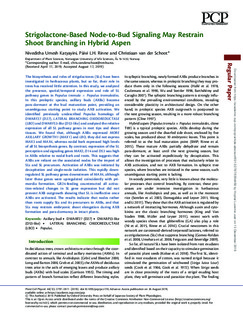| dc.contributor.author | Katyayini, Niveditha Umesh | |
| dc.contributor.author | Rinne, Paivi L.H. | |
| dc.contributor.author | van der Schoot, Christiaan | |
| dc.date.accessioned | 2020-01-03T12:46:49Z | |
| dc.date.available | 2020-01-03T12:46:49Z | |
| dc.date.created | 2019-10-28T09:47:14Z | |
| dc.date.issued | 2019 | |
| dc.identifier.citation | Plant and Cell Physiology. 2019, 60 (12), 2797-2811. | nb_NO |
| dc.identifier.issn | 0032-0781 | |
| dc.identifier.uri | http://hdl.handle.net/11250/2634806 | |
| dc.description.abstract | The biosynthesis and roles of strigolactones (SLs) have been investigated in herbaceous plants, but so far, their role in trees has received little attention. In this study, we analyzed the presence, spatial/temporal expression and role of SL pathway genes in Populus tremula × Populus tremuloides. In this proleptic species, axillary buds (AXBs) become para-dormant at the bud maturation point, providing an unambiguous starting point to study AXB activation. We identified previously undescribed Populus homologs of DWARF27 (D27), LATERAL BRANCHING OXIDOREDUCTASE (LBO) and DWARF53-like (D53-like) and analyzed the relative expression of all SL pathway genes in root tips and shoot tissues. We found that, although AXBs expressed MORE AXILLARY GROWTH1 (MAX1) and LBO, they did not express MAX3 and MAX4, whereas nodal bark expressed high levels of all SL biosynthesis genes. By contrast, expression of the SL perception and signaling genes MAX2, D14 and D53 was high in AXBs relative to nodal bark and roots. This suggests that AXBs are reliant on the associated nodes for the import of SLs and SL precursors. Activation of AXBs was initiated by decapitation and single-node isolation. This rapidly downregulated SL pathway genes downstream of MAX4, although later these genes were upregulated coincidently with primordia formation. GR24-feeding counteracted all activation-related changes in SL gene expression but did not prevent AXB outgrowth showing that SL is ineffective once AXBs are activated. The results indicate that nodes rather than roots supply SLs and its precursors to AXBs, and that SLs may restrain embryonic shoot elongation during AXB formation and para-dormancy in intact plants. | nb_NO |
| dc.language.iso | eng | nb_NO |
| dc.rights | Attribution-NonCommercial-NoDerivatives 4.0 Internasjonal | * |
| dc.rights.uri | http://creativecommons.org/licenses/by-nc-nd/4.0/deed.no | * |
| dc.title | Strigolactone-Based Node-to-Bud Signaling May Restrain Shoot Branching in Hybrid Aspen | nb_NO |
| dc.type | Journal article | nb_NO |
| dc.type | Peer reviewed | nb_NO |
| dc.description.version | publishedVersion | nb_NO |
| dc.source.pagenumber | 2797-2811 | nb_NO |
| dc.source.volume | 60 | nb_NO |
| dc.source.journal | Plant and Cell Physiology | nb_NO |
| dc.source.issue | 12 | nb_NO |
| dc.identifier.doi | 10.1093/pcp/pcz170 | |
| dc.identifier.cristin | 1741021 | |
| dc.relation.project | Norges forskningsråd: 263117 | nb_NO |
| dc.relation.project | NMBU - Norges miljø- og biovitenskapelige universitet: - | nb_NO |
| cristin.unitcode | 192,10,2,0 | |
| cristin.unitname | Institutt for plantevitenskap | |
| cristin.ispublished | true | |
| cristin.fulltext | original | |
| cristin.qualitycode | 2 | |

